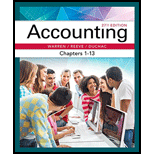
Accounting, Chapters 1-13
27th Edition
ISBN: 9781337272100
Author: Carl Warren, James M. Reeve, Jonathan Duchac
Publisher: Cengage Learning
expand_more
expand_more
format_list_bulleted
Question
Chapter 17, Problem 5DQ
To determine
Inventory Turnover Ratio
This ratio is a financial metric used by a company to quantify the number of times inventory is used or sold during the accounting period.
Formula:
a and b.
To determine: the indication of inventory turnover ratio
Expert Solution & Answer
Trending nowThis is a popular solution!

Students have asked these similar questions
October ! General accounting
I want the correct answer with accounting question
I want the correct answer with accounting question
Chapter 17 Solutions
Accounting, Chapters 1-13
Ch. 17 - Prob. 1DQCh. 17 - Prob. 2DQCh. 17 - A companys current year net income (after income...Ch. 17 - How would the current and quick ratios of a...Ch. 17 - Prob. 5DQCh. 17 - What do the following data, taken from a...Ch. 17 - a. How does the return on total assets differ from...Ch. 17 - Kroger, a grocery store, recently had a price-...Ch. 17 - Prob. 9DQCh. 17 - Prob. 10DQ
Ch. 17 - Horizontal analysis The comparative temporary...Ch. 17 - Prob. 17.1BPECh. 17 - Vertical analysis Income statement information for...Ch. 17 - Vertical analysis Income statement information for...Ch. 17 - Prob. 17.3APECh. 17 - Prob. 17.3BPECh. 17 - Accounts receivable analysis A company reports the...Ch. 17 - Accounts receivable analysis A company reports the...Ch. 17 - Inventory analysis A company reports the...Ch. 17 - Inventory analysis A company reports the...Ch. 17 - Prob. 17.6APECh. 17 - Long-term solvency analysis The following...Ch. 17 - Times interest earned A company reports the...Ch. 17 - Times interest earned A company reports the...Ch. 17 - Asset turnover A company reports the following:...Ch. 17 - Asset turnover A company reports the following:...Ch. 17 - Return on total assets A company reports the...Ch. 17 - Return on total assets A company reports the...Ch. 17 - Common stockholders profitability analysis A...Ch. 17 - Common stockholders profitability analysis A...Ch. 17 - Prob. 17.11APECh. 17 - Prob. 17.11BPECh. 17 - Prob. 17.1EXCh. 17 - Prob. 17.2EXCh. 17 - Common-sized income statement Revenue and expense...Ch. 17 - Vertical analysis of balance sheet Balance sheet...Ch. 17 - Horizontal analysis of the income statement Income...Ch. 17 - Current position analysis The following data were...Ch. 17 - Prob. 17.7EXCh. 17 - Current position analysis The bond indenture for...Ch. 17 - Accounts receivable analysis The following data...Ch. 17 - Accounts receivable analysis Xavier Scores Company...Ch. 17 - Inventory analysis The following data were...Ch. 17 - Inventory analysis QT, Inc. and Elppa Computers,...Ch. 17 - Ratio of liabilities to stockholders equity and...Ch. 17 - Ratio of liabilities to stockholders equity and...Ch. 17 - Ratio of liabilities to stockholders equity and...Ch. 17 - Prob. 17.16EXCh. 17 - Profitability ratios The following selected data...Ch. 17 - Profitability ratios Ralph Lauren Corporation...Ch. 17 - Six measures of solvency or profitability The...Ch. 17 - Five measures of solvency or profitability The...Ch. 17 - Prob. 17.21EXCh. 17 - Prob. 17.22EXCh. 17 - Earnings per share, discontinued operations The...Ch. 17 - Prob. 17.24EXCh. 17 - Prob. 17.25EXCh. 17 - Prob. 17.1APRCh. 17 - Prob. 17.2APRCh. 17 - Prob. 17.3APRCh. 17 - Measures of liquidity, solvency, and profitability...Ch. 17 - Solvency and profitability trend analysis Addai...Ch. 17 - Prob. 17.1BPRCh. 17 - Prob. 17.2BPRCh. 17 - Effect of transactions on current position...Ch. 17 - Measures of liquidity, solvency and profitability...Ch. 17 - Solvency and profitability trend analysis Crosby...Ch. 17 - Financial statement analysis The financial...Ch. 17 - Prob. 17.1CPCh. 17 - Prob. 17.3CPCh. 17 - Common-sized income statements The condensed...Ch. 17 - Profitability analysis Deere Company manufactures...Ch. 17 - Comprehensive profitability and solvency analysis...
Knowledge Booster
Similar questions
- Labor efficiency variance for October? General accountingarrow_forwardGeneral accounting questionarrow_forwardA company uses the weighted-average method for inventory costing. At the end of the period, 19,500 units were in the ending Work in Process inventory and are 100% complete for materials and 72% complete for conversion. The equivalent costs per unit are; materials, $2.75, and conversion $2.40. Compute the cost that would be assigned to the ending Work in Process inventory for the period.arrow_forward
- Financial Accounting questionarrow_forwardFor the Crestview Manufacturing Company, the average age of accounts receivable is 50 days, the average age of accounts payable is 40 days, and the average age of inventory is 68 days. Assuming a 365-day year, what is the length of the firm's cash conversion cycle?arrow_forwardHello tutor please provide correct answer general accounting question with correct solution do fastarrow_forward
arrow_back_ios
SEE MORE QUESTIONS
arrow_forward_ios
Recommended textbooks for you
 Managerial Accounting: The Cornerstone of Busines...AccountingISBN:9781337115773Author:Maryanne M. Mowen, Don R. Hansen, Dan L. HeitgerPublisher:Cengage Learning
Managerial Accounting: The Cornerstone of Busines...AccountingISBN:9781337115773Author:Maryanne M. Mowen, Don R. Hansen, Dan L. HeitgerPublisher:Cengage Learning Auditing: A Risk Based-Approach (MindTap Course L...AccountingISBN:9781337619455Author:Karla M Johnstone, Audrey A. Gramling, Larry E. RittenbergPublisher:Cengage Learning
Auditing: A Risk Based-Approach (MindTap Course L...AccountingISBN:9781337619455Author:Karla M Johnstone, Audrey A. Gramling, Larry E. RittenbergPublisher:Cengage Learning Cornerstones of Financial AccountingAccountingISBN:9781337690881Author:Jay Rich, Jeff JonesPublisher:Cengage Learning
Cornerstones of Financial AccountingAccountingISBN:9781337690881Author:Jay Rich, Jeff JonesPublisher:Cengage Learning

Managerial Accounting: The Cornerstone of Busines...
Accounting
ISBN:9781337115773
Author:Maryanne M. Mowen, Don R. Hansen, Dan L. Heitger
Publisher:Cengage Learning

Auditing: A Risk Based-Approach (MindTap Course L...
Accounting
ISBN:9781337619455
Author:Karla M Johnstone, Audrey A. Gramling, Larry E. Rittenberg
Publisher:Cengage Learning

Cornerstones of Financial Accounting
Accounting
ISBN:9781337690881
Author:Jay Rich, Jeff Jones
Publisher:Cengage Learning